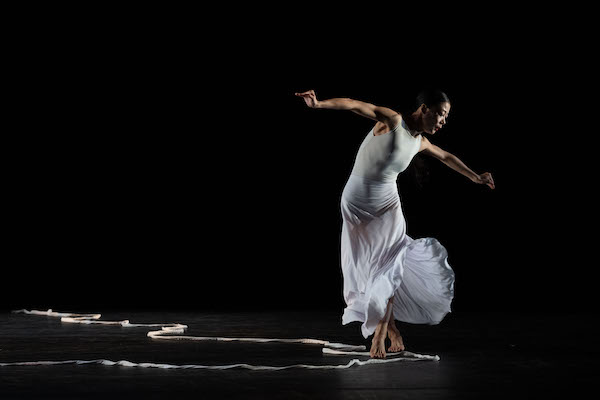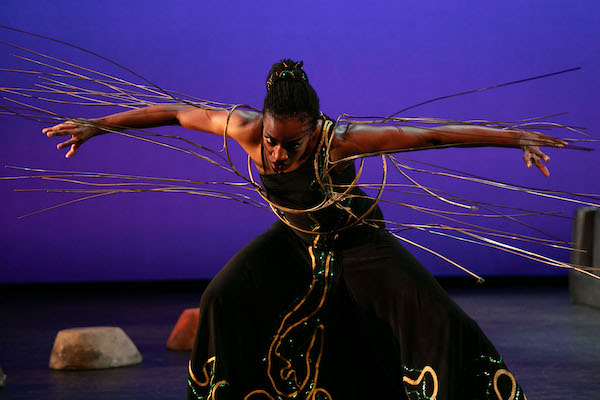Dance Review: The Martha Graham Dance Company — Straddling Past and Present
By Charles Giuliano
The two vintage works on the program at Jacob’s Pillow demonstrated, in a palpable manner, to what extent Martha Graham’s work changed everything.
Martha Graham (1894 -1991) had a long and intimate relationship with Jacob’s Pillow. She first trained with Ted Shawn, who was later to found the Pillow (he bought the Becket farm in 1931), and was featured in his work with Ruth St. Denis. Graham left after several years (in 1923) but continued to build on her early influences. In 1926 Graham founded her school and company, which is America’s oldest.
While Graham herself never performed at Pillow, The Martha Graham Dance Company has visited many times, including this past week. She created 181 works of which the company, under artistic director Janet Eilber, curates 50. Two new works are commissioned each year. There were many challenges to accomplishing this homage to the past because Graham viewed her dance as a living entity — she resisted documenting her work or securing copyright protection.

The Martha Graham Dance Company performing “Cave” in the 2023 Jacob’s Pillow Dance Festival. Photo: Christopher Duggan.
The first part of the program featured two modernist works from a series of twelve based on classical Greek tragedies, “Errand Into the Maze” (1947) and “Cave of the Heart” (1946). The second part of the evening featured the infectious “Cave” (2022) fashioned for the full company of twelve dancers by the Israeli choreographer, Hofesh Schechter. Earlier this season we saw a Schechter work commissioned by Gauthier Dance//Dance Company Theaterhaus Stuttgart. His “Swan Cake” (2021) contains neither swans nor cake.
The two works from the immediate post war period are emblematic of the era when the locus of experimental arts shifted from Europe and Paris to New York City. While these “classic” works feel mainstream today, at the time, they were radical and evoked mixed reactions from audiences and critics. Over the decades, Graham’s concepts and techniques have been so widely appropriated — indeed, they have defined much of the essence of modern dance — that it is difficult to comprehend now how challenging they once were.

Xin Ying in “Errand into the Maze” at the 2023 Jacob’s Pillow Dance Festival. Photo: Christopher Duggan
The two vintage works demonstrated, in a palpable manner, to what extent Graham’s work changed everything. Most profoundly was how she reconfigured tragic myths in ways that make strong and vengeful women the focus of the dances. In the tale of the Minotaur, for example, it is Ariadne — not Theseus — who enters the labyrinth to slay the monster. Despite her proclivity for spotlighting dominant women, Graham denied that she was a feminist.
Despite that response, Graham liberated and defeminized the constraints on women in the tradition of classical ballet. Rejecting performing en pointe, Graham danced with bare feet. She developed the Graham technique of tension and release, which is based on breathing. Along with those changes, she added sweeping circular movements whose power was emphasized by long, flowing skirts.
The famous set and designs by Isamu Noguchi (1904-1988) for “Errand Into the Maze” were destroyed by hurricane flooding. The dance has been reconstructred and redesigned by Maria Garcia (costumes) with lighting by Lauren Libretti.
The ominous music by Gian Carlo Menotti is grave, gut punching, dissonant, and enthralling. What’s left of the original concept is the threaded ribbon by which Xin Ying, as a furiously focused Ariadne, makes her way into and out of the maze. With astonishing power she sucks in and then forcefully releases her torso, cautiously making her way back and forth across the performance space, guided by a ribbon.
Poseidon sent a white bull to Minos, the King of Crete, to be sacrificed, an order which he ignored. In revenge, Poseidon made Pasiphae, the wife of Minos, fall in love with the albino bull. The resulting child was confined to a labyrinth designed by Daedalus. When mature, the Minotaur demanded that it be given human sacrifices. In the original myth, the hero Theseus slays the monster. Graham substituted Ariadne.
Nothing adequately prepares us for the entrance of Alessio Crognale-Robert’s monstrous Minotaur. On his shoulders is a club-like yoke with bulbous ends. As he keeps this in place, the dancer simulates horns, his arms raised with splayed fingers. A mesh mask further dehumanizes the creature. The reference to a bull’s horns makes him more bestial, undercutting his stature as a half-human demigod. The prop restricts his movement as Ariadne initially seduces and then slays him.

Leslie Andrea Williams in “Cave of the Heart” at the 2023 Jacob’s Pillow Dance Festival.Photo: Christopher Duggan
“Cave of the Heart” boasts the powerful music of Samuel Barber as well as a reconstruction of the famous Noguchi set and its sculptural props. Graham reduced and reshaped the tragedy of the sorceress Medea who, when abandoned by Jason, seeks bloody revenge.
This production featured the astonishingly forceful Leslie Andrea Williams as the vengeful Medea. The inevitably pumped-up machismo of Jason is evoked by Lorenzo Pagano. The princess bride of Jason, attired in innocent white, is danced by Laurel Dalley Smith. The robed Ane Arrieta serves as the Chorus. Graham has spared us the grim murder of Medea’s children.
One winces at the actions of a woman scorned. For his part, Jason preens, flexes his muscles, and strikes powerful poses. The princess is depicted as a paradigm of innocence and delicate beauty. The Chorus, by way of a sweeping frenzy, warns of what is to come — all to no avail.
In seeming acquiescence and homage, Medea places a crown on the head of her rival. Initial pleasure turns to anguish as the crown becomes an instrument of torture and death. Medea eventually places herself in Noguchi’s sculptural construction, an assemblage of quivering, thin rod projections. It is familiar as a sculptural work of art — it is fascinating to see it function as a prop.
Given all that emotional intensity, Schechter’s “Cave” provided a fun release. The percussion by Ame and Schechter that began the piece sounded like rolling thunder. That later morphed into synth and drum ostinatos. It was a pulsing, hip-hop, club sound.
The performance offered a sharp contrast to Graham’s stark, stylized movements. In “Cave,” twelve dancers emphatically propelled themselves via their upper bodies, arms, hands, and fingers. They clustered together, simulating a crowded club with contagious, hypnotic, zonked expressions. The result was an evocation of a disco-like frenzy fed by a hedonistic consumption of poppers and ecstasy. The dancers marched and stomped to a hypnotic, repetitive beat.
Shechter’s trendy choreography demonstrated how The Martha Graham Dance Company aptly straddles past and present.
Charles Giuliano has just published Annisquam: Pip and Me Coming of Age.
Tagged: Errand Into the Maze, Jacob's Pillow Dance Festival, Janet-Eilber, Martha-Graham

This past Sunday, I saw the MARTHA GRAHAM DANCE COMPANY, at Jacob’s Pillow.
I am astounded, the Graham Company, would present two very “ARTISTICALLY DATED” productions at the “RENOWN” Jacob’s Pillow.
As for the HOFRESH SHECHTER “CARE” which took up all of the second half…Exhausting, loud, nonstop chaos.
[A big ditto for SHECHTER’s “SWAN CAKE” which was recently performed at the Pillow as part of GAUTHIER Dance.]